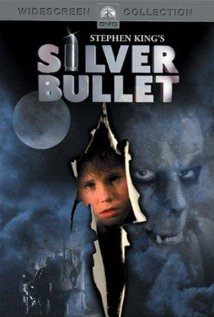The difference between this and the standard, cookie-cutter, grade-B monster/werewolf/e-mail-spammer horror flick could be a tutorial for playwrights, screenwriters and cinematographers. Instead of the tired horror-flick plot – monster terrorizes small town after killing some folks (usually with heavy-handed special-effects gore, repeated frequently throughout); populace panics and does a lot of stupid things; standard-issue hero arrives; standard-issue sexy young heroine falls in love with him and the movie ends with the standard-issue hero dispatching the monster moments before monster is about to make standard-issue heroine his/her/its next victim – this one deftly draws on strong theatrical principles and creativity to make the viewing real entertainment.
The young protagonist, who could be a paraplegic edition of ELL-LEE-YUHHT from E.T., his mid-teenage sister, which character, as an adult, opens the story with off-camera narrative (by Tovah Feldshuh), and an equally-charming third kid, who happens to be the boy’s uncle and is chronologically but in no other respect an adult, endearingly played by Gary Busey, are developed skilfully as characters in their own right, entirely apart from the werewolf theme. By making us know and care about them, as well as the lesser characters, King creates a warm and personal relationship between them and the audience, something rarely achieved in standard horror/suspense fare. Busey is just right as the uncle who finds responsibility to be rather an impediment to enjoying life.
Injecting just the right touch of comedy where you’d least expect it and making it work – to avoid spoiling, I’ll just say something about the woods at night and a bunch of people who don’t belong there – a few red herrings to keep you guessing, and one broad clue to the identity of the werewolf that the sharp-eyed and -eared might catch but is otherwise not at all tipping a hand, all combine to hold the interest and attention of the viewer. The knitting-together of various threads – the significance of the monster’s attack on the suicidal woman, for one – creates a certain intricacy that typical monster-flick shows rarely have.
Some blood and gore is unavoidable in a story like this; but again, it’s handled with skill and delicacy instead of blunt force. The attack scenes are crafted to use the viewer’s imagination much more than the special-effects department to create the impression. Watch carefully and you’ll notice that the illusion is created by alternating very brief flashes of action streaking by the lens, almost too fast to discern, with establishing shots of the victim’s accumulating injuries, with the audio gluing it all together. A few frames of the monster’s snout or eyes moving past, a claw (or later on, a club or baseball bat) streaking by, but not not visibly headed for any particular target, horrified looks and increasing amounts of blood from the victim who may get tossed across the room or otherwise propelled violently but you never see the propelling directly, and your imagination does the rest.
It’s not the masterpiece of the ages; but it’s a film to enjoy once, and then, if you’re into the theatrical arts at all, see again – for study.

